|
| ||||||
mailto: blog -at- heyrick -dot- eu
You are not reading my b.log using HTTPS. You can switch to HTTPS by clicking here. ProroguingIt's no news that the British Parliament is to be shut down (prorogued) for an extended number of days. While only the Queen is able to issue the right to prorogue Parliament, her doing so does not mean she supports Brexit, as some have suggested. In actual fact, Her Majesty takes advice from the Prime Minister. And since he is the one wanting everything shut down... you can see where this is going.It is expected that following the shutdown, he will declare a General Election. This, too, shuts down Parliament for the election process. It's a risky gamble (he might lose) but it ought to more or less mean that Parliament doesn't get to debate anything related to Brexit, and the date of leaving will come... and go... And the UK will then be "out means out".
The problem here is that Britain is run as a Parliamentary Democracy. This means that the functioning of the government is not dictated by the citizens, by mob rule, by referenda, or the media (although all can have an influence on important topics). Instead, it is down to the elected representatives of the citizens (note very clearly - Nigel Farage is not one, yet he currently weilds more power than most MPs) to sit and debate, to scrutinise, to examine. Proposals will be passed to the Lords for a more learned scrutiny, and then back to the Commons. It's a little bit convoluted, but that is basically how it works.
But, wait, it's taken three years and nobody has any sense of agreement on what is actually wanted!? Yeah, that's true. Part of the reason lies with the fact that Brexit is an In or Out scenario. There is no middle ground. EFTA was rejected because that's basically In without actually being In. That leaves... Remaining, or Leaving. Polar opposites.
Where does this leave Britain? Well, given that the Home Office is actively refusing citizenship rights to people who've spent most of their lives in the UK and the government wants to raise the age of retirement to 75; I think it's time for a wider look at the state of the country and ask "what does Britain stand for?" and "can it even survive the sort of economic shock that a crash-out Brexit will bring?".
As for me, personally? How many years down the line and still no clear idea what the hell the future holds. I don't mean in an "I'll marry a cute Canadian and we'll have two daughters" because I could be killed in a car crash tomorrow. But given that I came here seventeen years ago as a European citizen, and used my European rights to live and work in a European country..... rights which look to be terminated soon by others. All France has really said on the matter is that it expects continuation of rights to be reciprocal. But given that the current Home Secretary leans to the far right (and has argued that it is wrong for citizens to hold the government to account via the courts - WTF?), I don't expect good things in the future.
Livebox PlayI was recently given a Livebox Play, the third major revision of the Livebox range from Orange.The press wasn't overly impressed, given that the Livebox 2 seemed little more than a Livebox Mini in a different box. They seemed to feel that the Livebox Play was basically a rehashing of the Livebox 2, only this time in a black box instead of a white one, but it seems that there are a reasonable number of changes inside even if the HTML-based user interface looks identical. First, let's look at the box. Here's the front: 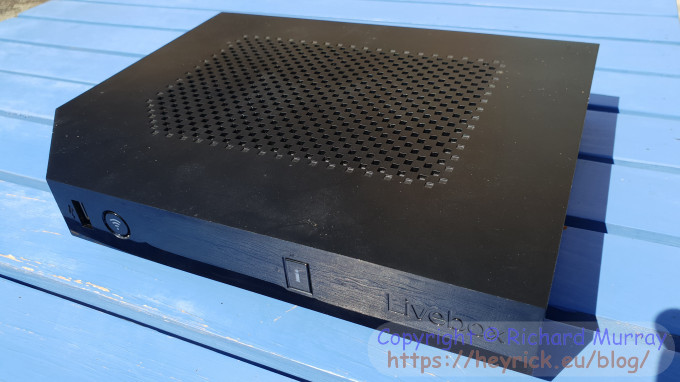 To the right of the button is a big blank space. That blank space is actually an orange coloured matrix display (something like 128×32) that gives status messages and information. In normal use the display will be off, and the 'i' button to the right of the display will glow green if everything is okay, and red if not. Pressing the button will call up information and messages. No more trying to decode a row of glowing LEDs with strange symbols beside them. Now, the back: 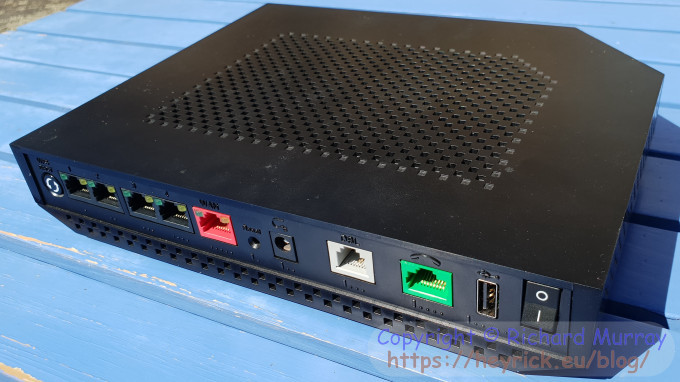 Beside that is a Reset button. Unlike most other devices on the planet, this does not reset the box. It resets the internal configuration (if you want to reset the box, just turn it off and on again). A barrel connector is the fairly standard 12V power supply. This is followed by a grey RJ11 socket (it's a little narrower than the RJ45 Ethernet sockets) for connection to the incoming phone line for DSL. Next, a green RJ11 socket for connection to a splitter that provides a normal phone socket. In France, phone sockets are massive. This provides VoIP and works with any traditional DTMF telephone. It can run an old mechanical dial phone, but the Livebox does not understand loop-disconnect dialling. You'll need to fit an adaptor to translate pulses into tones - something like the Rotatone. Finally, another USB 2 socket (for harddiscs and printers and stuff likely to be left connected) and a flick-switch for turning the box on and off. The Livebox 2 offered an Ikanos ADSL chip with an ADI Fusiv 160 processor at about 200MHz, 128MiB RAM, 32MiB Flash, standard 2.4GHz WiFi b/g/n, 2 USB 2 sockets, and four 100Mb ethernet sockets.
The Livebox 3 (known as Livebox Play) released in 2013 upped the specification. The processor is now an Ikanos Vx185 clocking 500MHz. 128MiB RAM (DDR2-400) and 128MiB NAND Flash make this a worthy enough upgrade from the older Livebox 2. But, wait, there's more. Let's whip the lid off. There are four screws hidden underneath rubber feet. The screws are star-shaped, but any worthy geek won't be fazed by weird screws. Perhaps stranger is that there is no fifth screw hidden under a fragile label, or an obvious "void if broken" sticker. 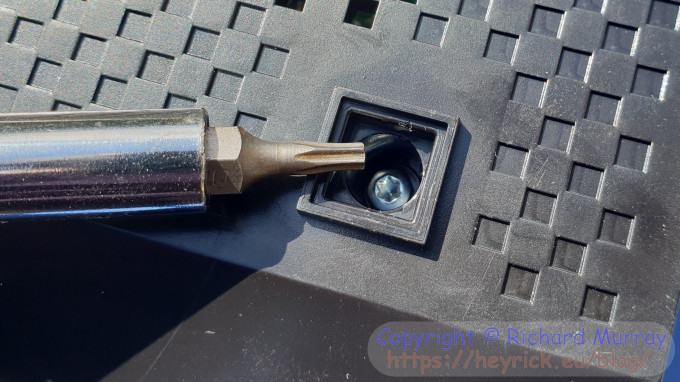 With the top off, we can look at a fairly empty looking motherboard: 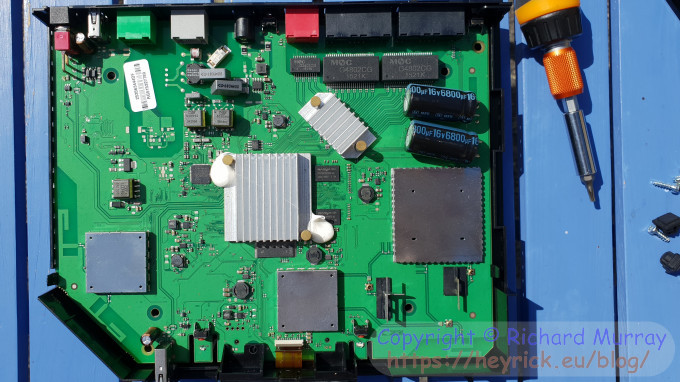 I had the silver can lids off earlier (but not the heatsinks - don't touch those if you plan to use the box!) but not for this photo. Why a new photo? The older one was done on a cloudy day and it looked rubbish. Anyway, let's start at the front left: 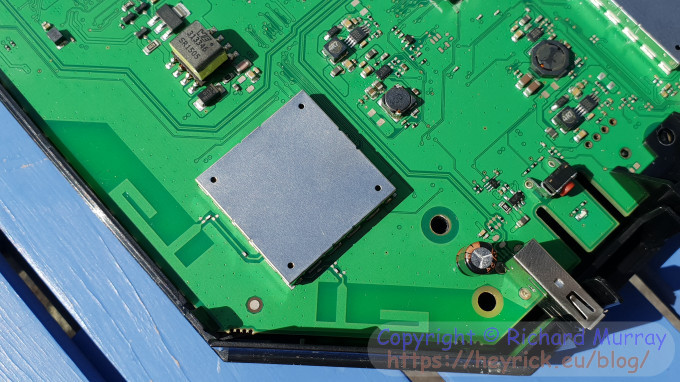 Across to the front right, we see some interesting things: 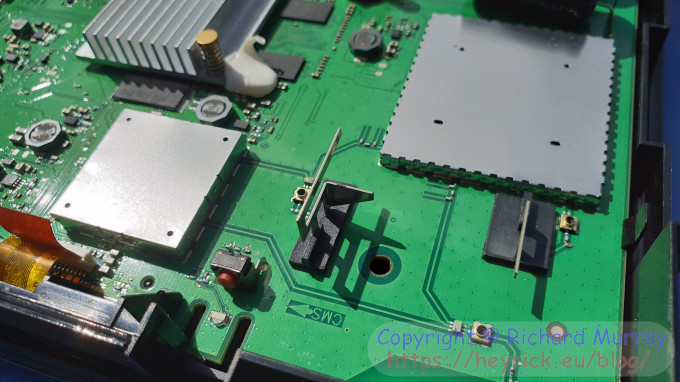 But there's something even stranger. Do you see the two silver boxes? Well, the one on the left is an Atheros AR9382 that is a dual-band WiFi controller that can work with 801.11b/g for 2.4GHz and 802.11a for 5GHz, and 802.11n in both bands. It is likely that this controller is being used purely for traditional 2.4GHz because... The box on the right is an Atheros AR9380 which is a faster WiFi chip, and one would imagine this is being used for the 5GHz band. It's strange having two WiFi chips, but might indicate a general shift to more WiFi-based devices such as phones and tablets. For what it is worth, given the thick walls and a desire to air-gap things to try to minimise the potential damage of lightning strikes, nothing here is wired other than a cheap DECT phone (out of necessity). Rear-right now: 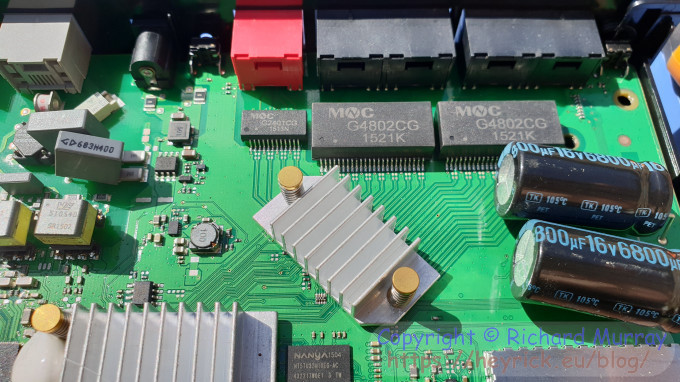 Across to the rear-left: 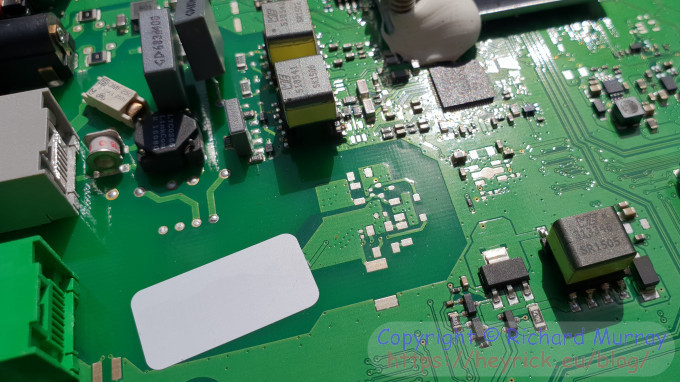 Also of note is that the barrel connector for the power (behind the grey phone socket) is connected to the rest of the board by two zero ohm links. I would imagine the pads are to permit diodes to be fitted to protect the board in case an incompatible power supply (with reverse polarity) is plugged in by accident. It's no big deal feeding 5V or somesuch to a device expecting 12V. It is a bigger deal getting the polarity wrong. More interestingly, the little chip by the big white blob is an Ikanos FXS7OIF1 which is an ADSL interface capable of ADSL (up to ADSL2+) and also VDSL2. VDSL is a new technology that claims to achieve up to 100Mbit downstream and upstream using standard twisted-pair copper cabling. It is really only useful in cities as the maximum rate of 100Mbit is only available up to around 500 metres from the cabinet, up to a kilometre it is around 50Mbit, and at around 1.6km its performance is akin to ADSL2+, but unlike the original VDSL it can achieve 1-4Mbit at 4-5km distances. Finally, in the middle: 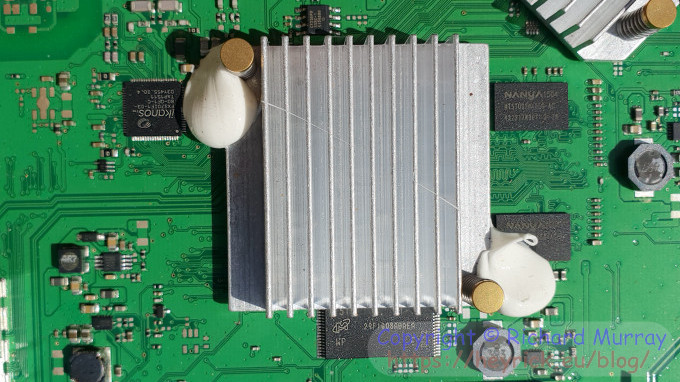 And, finally, the MIPS core SoC which contains a DDR2 memory controller, two PCIe ports (used for the WiFi), and a two port USB controller. They missed a trick here. The SoC has onboard SATA.
In use, setting it up as simplicity itself because I cheated. I saved my configuration from the Livebox 2 and tried loading it on the Livebox Play. It actually worked, and set up the Livebox Play as an almost-exact clone of the current Livebox. Almost - it didn't change the login password (by default part of the MAC address) and it didn't seem to copy over device names, though it did keep MAC addresses and assigned IP addresses. In use, nothing happens for about twenty seconds. Then the display shows the Orange logo for about half a minute. It then pops up a message saying that it will be connected to the Orange network in two minutes. An earlier firmware used to provide more details of the boot stages, along with a sliding bar animation for how much had been done, but a firmware update got rid of that. I guess it's only geeks like myself that care what a box is doing while it boots.  The Livebox Play is quicker at doing the actual booting (well, it's not hard to beat the Livebox 2, you could probably defrost a freezer faster than it takes that thing to boot) but it appears to take longer to perform the actual DSL synchronisation. Again, the original firmware used to say when it had ADSL sync, when it was logging in, and so on. But no longer. You only get a message if it goes wrong.
I would imagine that things "run faster". But I didn't test features like media sharing. I did notice that it consistently maintained a faster ADSL link.  Now, as I sit here, at the end of around 4700 metres of twisted pair and numerous patches and joints and fixes, I find it quite mind-blowing that an overhead rural phone line that may well predate my existence actually manages to sync at 4.4 megabits. That works out to be about half a megabyte per second. So, that'll be Amazon Prime Video streaming in fullHD then... ☺ But we're not done yet. There's another big change lurking inside this box. IPv6.
At last. But having IPv6 available is a start, and I noticed that my HP printer was using it.
I have reverted to the Livebox 2 for one simple reason. The Vonets (that provides the Pi's connectivity) appears to associate itself not by SSID like everything else, but by MAC address. As such, it doesn't recognise the Livebox Play. It's a simple enough thing to fix, but I can't be bothered doing it right now.
Your comments:Please note that while I check this page every so often, I am not able to control what users write; therefore I disclaim all liability for unpleasant and/or infringing and/or defamatory material. Undesired content will be removed as soon as it is noticed. By leaving a comment, you agree not to post material that is illegal or in bad taste, and you should be aware that the time and your IP address are both recorded, should it be necessary to find out who you are. Oh, and don't bother trying to inline HTML. I'm not that stupid! ☺ ADDING COMMENTS DOES NOT WORK IF READING TRANSLATED VERSIONS.
|
(Felicity? Marte? Find out!)
📺 The SIBA stories 📹
It's a simple substring match.
Last read at 06:04 on 2024/04/18.


| ||||
| Next entry - 2019/09/07 Return to top of page |
| © 2019 Rick Murray |
| Retrieved from http://www.heyrick.co.uk/blog/index.php?diary=20190901 on 18th April 2024 |


